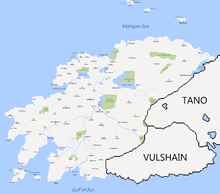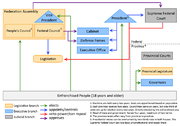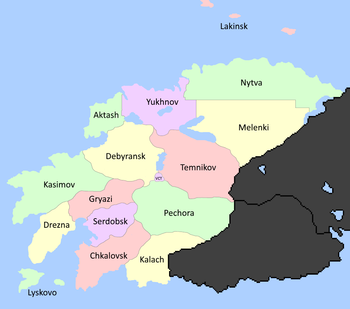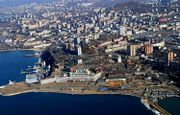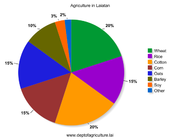Difference between revisions of "Laiatan"
(→History) |
|||
| Line 17: | Line 17: | ||
===Prehistory=== | ===Prehistory=== | ||
===Mahigan era=== | ===Mahigan era=== | ||
| − | ==== | + | ====Grand Principality of Volkgoroda==== |
====Kingdom of Laiatan==== | ====Kingdom of Laiatan==== | ||
===Laiatanese Empire era=== | ===Laiatanese Empire era=== | ||
Revision as of 23:35, 19 April 2018
| This page is a work in progress by its author(s) and should not be considered final. |
| Laiatanese Federation Лаиатанский Федерация Laiatanskiy Federatsiya |
||||||
|---|---|---|---|---|---|---|
|
||||||
| Motto: "Мы верим нашей Матери." "My verim nashey Materi." "We trust our Mother." |
||||||
| Anthem: Наша Родина-мать Nasha Rodina-mat Our Motherland |
||||||
The Laiatanese Federation.
|
||||||
| Capital and largest city | Volkgoroda | |||||
| Official languages | Laiatanese official throughout the country | |||||
| Ethnic groups (2012) | 45.1% Southern lupine 38.5% Northern lupine 15.5% mixed 0.9% other |
|||||
| Demonym | Laiatanese | |||||
| Government | Federal presidential constitutional republic | |||||
| - | President | Yuliya Surkova | ||||
| - | Vice President | Vladimir Burmakin | ||||
| - | Chairman of the People's Council | Kiril Zhutov | ||||
| - | Chief Justice | Yulia Danilova | ||||
| Legislature | Federation Assembly | |||||
| - | Upper house | Federal Council | ||||
| - | Lower house | People's Council | ||||
| Formation | ||||||
| - | Grand Principality of Volkgoroda | 365 | ||||
| - | Kingdom of Laiatan | November 9, 1154 | ||||
| - | Laiatanese Empire | July 8, 1577 | ||||
| - | Laiatanese Federation | April 17, 1888 | ||||
| Area | ||||||
| - | Total | 1,396,700 km2 539,268 sq mi |
||||
| - | Water (%) | 3.6% | ||||
| Population | ||||||
| - | 2018 estimate | 75,549,180 | ||||
| - | 2012 census | 67,035,478 | ||||
| - | Density | 54.1/km2 140.1/sq mi |
||||
| GDP (nominal) | 2018 estimate | |||||
| - | Total | $3.425 trillion | ||||
| - | Per capita | $45,344 | ||||
| Gini (2012) | low |
|||||
| HDI (2012) | very high |
|||||
| Currency | Korona (KOR) (Ժ) |
|||||
| Time zone | (UTC+4) | |||||
| Date format | mm-dd-yy | |||||
| Drives on the | right | |||||
| Calling code | +57 | |||||
| ISO 3166 code | LAI | |||||
| Internet TLD | .lai | |||||
Laiatan (Laiatanese: Лаиатан, tr. Laiatan), officially known as the Laiatanese Federation (Laiatanese: Лаиатанский Федерация, tr. Laiatanskiy Federatsiya), is a country situated on the western part of the continent of Itur, which is located in The East Pacific. It is a federal presidential constitutional republic, comprising of 15 provinces and one federal territory. Laiatan borders the Commonwealth of Tano, which is controlled by South Hills to the northeast, and the Confederacy of Vulshain to the southeast. It is renowned across the region for being the homeland of the lupines, a wolf-like species that make up roughly 97% of the total population.
Before the formation of the Grand Principality of Laiatan in 365, the nation was splintered into several different tribal federations. These tribes have made their mark on modern day Laiatan, each culture shaped the culture of the regions of Laiatan. The Mahigans, a small tribe that built a home for itself along the banks of what is now known as the Mahigan River, grew in wealth and numbers and eventually grew strong enough to start subjugating fellow tribes sometime in the 580s. By 1154, the Kingdom of Laiatan was formed by Chief Yura Romanovich Lainov of the Mahigans. Four hundred years later in 1577, the Laiatanese Empire was created.
On July 8, 1880, a group of right-wing army officers seized power in a coup d'état led by General-Colonel Leonid Arzamastsev and General-Majors Artyom Grebenshchikov and Milorad Kosterlovovich. Using surprise and confusion, Arzamastsev took power quickly and arrested leading politicians, authority figures, and citizens believed to be threats to the new regime. With much of Laiatan under the control of the coup leaders and with fighting widespread, and Emperor Yuri IV called for a cease in hostilities and swore in the dictators as the legal government. Five years later and after numerous civil rights abuses, fighting broke out again between forces loyal to the junta and royalist troops. Fighting would end in late 1886, with royalist troops overthrowing the military government. A referendum was held in early 1887 to determine what form of government the country would take, and there was an overwhelming amount of support to establish a republic. On April 17, 1888 the Laiatanese Federation was created with a constitution, president, and legislature elected by the people. Aleksey Zukov would go on to become the first President of Laiatan.
The Laiatanese Federation is a highly developed nation that is filled with fiercely patriotic people, viewing themselves as brothers and sisters of the Federation. The country has been involved in several military incursions outside of its borders. Laiatanese forces invaded their neighbor Vulshain twice in twenty years in order to bring the country to peace, once during a revolution, the other during a civil war. The country is a signatory to the Kerilo Accord.
Contents
Etymology
History
Prehistory
Mahigan era
Grand Principality of Volkgoroda
Kingdom of Laiatan
Laiatanese Empire era
Junta era
Civil War
Early Federation
Recent history
Politics
Governance
See also: Laiatanese Constitution
The country is a federation and a presidential constitutional republic, where the president is both head of state and government. In the Laiatanese federalist system, citizens are subject to three levels of government: federal, provincial, and local. The local government's duties are commonly split between county and municipal governments. In almost all cases, executive and legislative officials are elected by a plurality vote of citizens by district. There is no proportional representation at the federal level, and it is very rare at lower levels. The Laiatanese Federation is fundamentally structured as a multi-party representative democracy, with the federal government composed of three branches that regulate each other by a system of checks and balances:
- Executive: The President is the Supreme Commander-in-Chief of the Defense Forces, can veto legislative bills before they become law, and appoints the Government of Laiatan (Cabinet) and other officers, who administer and enforce federal laws and policies.
- Legislative: The bicameral Federation Assembly, made up of the Federal Council and the People's Council, makes federal law, declares war, approves treaties, has the power of the purse, and has the power of impeachment, by which it can remove sitting members of the government.
- Judiciary: The Supreme Federal Court and lower federal courts, whose judges are appointed by the president and confirmed by the Federal Council, interpret laws and overturn those they find unconstitutional.
The president is elected by popular vote for a four year term (eligible for a second term, but not a third consecutive term).
The People's Council has 450 voting members, each representing an electoral district for a two year term. Seats are apportioned among the provinces by population every eight years. At the 16th National Census taken in 2012 Kalshkavo, the least populous province, had two representatives while Trakovaski, the most populous province, had forty-three. The Federal Council has thirty-two voting members with each province having two, elected at-large to six-year terms; one third of Federal Council seats are up for election every other year.
The Supreme Federal Court, led by the Chief Justice of Laiatan, has twelve members who serve for life. The Chief Justice is selected by the President and confirmed by the Federal Council.
The provincial governments are structured in a roughly similar fashion. The governor (chief executive) of each province is directly elected. Some province judges and cabinet officers are appointed by the governors of the respective provinces, while others are elected by popular vote.
Foreign relations
Laiatan currently maintains diplomatic relations with almost every nation in the region, though it is friendlier to some. Laiatan is a founding member of the Itur Treaty Organization (ITO), and also houses the headquarters of the organization. It's played a leading role in the organization as well as in its actions. It has grown closer to the nation of Vulshain following Samuil Rainard's rise to power. Previously these nations could be considered enemies, previously going to war when Vulshain invaded.
Laiatan's relations with Vekaiyu are slowly warming up in the years after a Vekaiyun submarine attacked several Air Force helicopters and killed ten airmen. The crew of the submarine are serving life terms in the Federal Correctional Complex located in Eisborn. The submarine was returned to Vekaiyu after being "inspected" by federal agents. Vekaiyu also agreed to paying reparations to the families of the killed airmen. It's expected that both nations will become friendlier towards one another, though some reservations would remain.
In an attempt to foster better relations between Laiatan and the nation of Tano, president Zakhari Kreskov was going to be travelling to Tano with other world leaders including Premier Ikrisia Levinile of Vekaiyu, the president of Bachtendekuppen, and President Melodom of Aelitia. Unfortunately, this was cancelled due to an unprovoked invasion by Dveria, which was fought off by the combined force of Laiatanese, Vekaiyu, South Hill, and Listonian forces.
Military
Main article: Laiatanese Defense Forces

Military service is voluntary, though conscription may occur "when a crisis has overwhelmed the voluntary military force", through the Emergency Draft System. Forces can be rapidly deployed through the extensive transport aircraft fleet of the Air Force, or through the three aircraft carriers currently in service with the Navy.
The country invaded the island nation of Rygard with Vulshain and overthrew the military junta. The country voted to become part of Vulshain - following which Laiatan pulled all troops from the island and filed a letter of protest against the Vulshainian government for accepting the vote. The Laiatanese military also participated in a large scale invasion of Dveria with the assistance of Vekaiyu, SHACOG, and BGP, and is currently occupying the northern half of the country in accordance with the Kerilo Accord.
Political divisions
Main Article: Subdivisions of Laiatan
See Also: List of Laiatanese subdivisions by population
Laiatan is a federation comprised of fifteen provinces and one federal territory. Provinces are split into raions for administrative purposes.
Provinces hold all power not delegated to the federal government according to the Constitution. This means that they must have a representative republic style of government, obey the Constitution, as well as remain subordinate to the federal government. They are not allowed to unilaterally secede from the Federation. Beyond this, they are fully autonomous: they ratify their own constitutions, freely organize their local governments (in accordance with the Constitution), and own and manage their own natural and financial resources. Every province has a bicameral legislature, similar to that of the federal legislature.
Every province and the capital territory receives four Federal councilmen in the Federal Council, as well as a set number of seats in the People's Council based upon population.
Law enforcement, judiciary, and crime
Main article: Law enforcement in Laiatan
Law enforcement in the Laiatanese Federation is generally the responsibility of local police and sheriff's departments, with provincial police providing broader services. The Volkgoroda Metropolitan Police Department, which serves the Volkgoroda metropolitan area, is the largest in the country. Federal agencies like the Federal Investigative Service (FSR) and the Narcotics Enforcement Agency (NPA) have specialized duties, including protecting civil rights, investigating federal and international crimes, national security, enforcing drug laws, and investigating drug offenses. At the federal level and in every province, the legal systems operate on common law. Provincial courts conduct most criminal trials; federal courts handle certain designated crimes as well as certain appeals from the provincial criminal courts. Plea bargaining is very common; the vast majority of criminal cases in the country are settled by plea bargain rather than jury trial.
Judiciary
Main article: Judiciary of Laiatan
Laiatan's judiciary is the system of courts responsible for interpreting and applying Laiatanese law. The Laiatanese legal system is based on common law, and employs an adversarial system for determining the outcome of cases.
Crime statistics
Geography
Laiatan is situated on the western part of the Itur continent, providing a massive coastline ripe for the nation's shipping industry. To the east are the Great Appalach Mountains, which separates Tano and Vulshain from Laiatan. The Vysoki Mountain Range dominates the northern landscape.The lowest point of elevation in Laiatan is the Green Basin, located inside the Greenville Nature Preserve, at -290 ft (-88.4 m) below sea level. The highest point is Vysoki Mountain at 16,985 ft (5,177 m) above sea level.
Laiatan has fifteen provinces and one federal capital territory based on culture, history and geography. These provinces serve administrative purposes, as well as acting as an important part of citizens' self-identity. While most citizens see themselves as 'brothers and sisters of the Federation', many citizens also see themselves as a member of their somewhat autonomous province.
Much of southern Laiatan is agricultural. Heavy industry is also found in the center and north of the country, fueling the large population centers of the central region. The highest population density is in the center of the country, the location of many factories and job creators. Eis Island and Turnov Island are Laiatan's largest islands, which are part of the Kalskavo Island chain. Saphir Lake is the nation's largest lake.
Biodiversity
Climate
In the Köppen climate classification, the country is split into three climate zones. The majority of the country lays within the boreal zone, characterized by warm summers and freezing winters. Within the country, the temperateness varies considerably between the southern coastal regions and the extreme north, showing characteristics of hemiboreal, boreal, and tundra climate.
Winters in southern Laiatan (when mean daily temperature remains below 0 °C or 32 °F) are usually about 100 days long, and in the inland the snow typically covers the land from about late November to April, and on the coastal areas such as Izmurod, snow often covers the land from late December to late March. Even in the south, the harshest winter nights can see the temperatures fall to −30 °C (−22 °F) although on coastal areas like Izmurod, temperatures below −30 °C (−22 °F) are very rare. Climatic summers (when mean daily temperature remains above 10 °C or 50 °F) in southern Laiatan last from about late May to mid-September, and in the inland, the warmest days of July can reach over 35 °C (95 °F). Although most of Laiatan lies on the taiga belt, the southernmost coastal regions are sometimes classified as hemiboreal.
In northern Laiatan, particularly in Kekur, the winters are long and cold, while the summers are relatively warm but short. The most severe winter days in Kekur can see the temperature fall down to −45 °C (−49 °F). The winter of the north lasts for about 200 days with permanent snow cover from about mid-October to early May. Summers in the north are quite short, only two to three months, but can still see maximum daily temperatures above 25 °C (77 °F) during heat waves. The northernmost areas of Kekur, a small part of Zukovsk, and Kalshkavo have a tundra climate.
The Laiatanese climate is suitable for cereal farming only in the southernmost regions, while the northern regions are suitable for animal husbandry.
Economy
| Economic Indicators | |
| Nominal GDP | $3.131 trillion (Q4 2015) |
| Real GDP growth | 2.5% (Q4 2015) |
| CPI inflation | 1.9% (February 2012 - February 2013) |
| Employment-to- population ratio |
70% (April 2013) |
| Unemployment | 4.8% (June 2015) |
| Labor force participation rate |
77% (April 2015) |
| Poverty | 6.2% (2015) |
Laiatan has a capitalist mixed economy which is fueled by abundant natural resources and high productivity. It also includes a highly skilled labor force, large capital stock, low levels of corruption and a high level of innovation. The service sector contributes approximately 67% of the total GDP, industry 31%, and agriculture 2%. The official average national unemployment rate in June 2013 was 4.8%.
Laiatan exports more than it imports, and has a trade surplus. The trade surplus in 2015 was $156 billion. In 2015, the largest import commodity was machinery. The largest export commodity in 2015 were fossil fuels (includes oil, natural gas, etc.) and precious materials.
In 2009, the private sector was estimated to constitute 84.4% of the economy, with federal government activity accounting for 6.3% and province and local government activity (including federal transfers) the remaining 9.3%. While its economy has reached a postindustrial level of development and its service sector constitutes 67.8% of GDP, Laiatan remains an industrial power. The leading business field by gross business receipts is wholesale and retail trade; by net income it is manufacturing.
Chemical products are the leading manufacturing field. It is a top producer of electrical and nuclear energy, as well as liquid natural gas, sulfur, phosphates, and salt. While agriculture accounts for just 2% of GDP, Laiatan is a top producer of wheat, rice and cotton. The National Statistics Service for Agriculture maintains agricultural statistics for products that include; wheat, rice, corn, cotton, oats and barley. In addition, the Ministry of Agriculture provides livestock statistics regarding beef, poultry, pork, along with dairy products. The Mining Association of Laiatan provides data pertaining to coal and minerals that include; aluminium, beryllium, copper, lead, magnesium, zinc, titanium and others.
Consumer spending comprises 71% of the Laiatanese economy in 2013. In August 2010, the Laiatanese labor force consisted of 44.5 million people. With 5.7 million people, government is the leading field of employment. The largest private employment sector is health care and social assistance, with 6.4 million people. About 52% of workers are unionized. Laiatan's federal government guarantees its workers with a minimum of 34 days paid vacation (20 paid days off, 13 public holidays) and also guarantees its workers with 12 weeks of paid family leave.
Agriculture
The total area of cultivated land in Laiatan was estimated at 79,439 square miles (205,745 km2) in 2013. The production of meat has grown from 2.8 million tons in 2003 to 3.4 million tons in 2013.
In the years following the creation of the Federation, crop yields significantly increased. The provisional military government offered incentives to farmers that could produce large numbers of certain types of crops needed by the people of the country as well as the military. These incentives directly affected the future crops grown in Laiatan, combined with the climate, and today the main crops grown in Laiatan are reminiscent of the crops wanted by the government. Due to the large number of crops produced then and now, Laiatan is a major exporter of agricultural goods.
Today, large farms produce a large amount of agricultural goods, while small family owned plots still play a major role in the growth of Laiatanese agriculture.
With a large coastline, Laiatanese fishing fleets are a major contributor to the region's fish supply. The total capture of fish was at 1,191,068 tons in 2005. Both exports and imports of fish and sea products grew significantly in the recent years, reaching correspondingly $2.1 and $1.7 millions in 2008.
Energy
In recent years, Laiatan has been described in the media as a major energy producer. The country has a large number of oil, natural gas and coal reserves, much of which still remains untapped. Laiatan is a major oil, natural gas and coal exporter, exporting the excess resources removed from the ground, making it completely energy independent. On 1 January 2011, per the ITO treaty, Laiatan announced it had begun shipment of 250,000 barrels of oil a day to Vulshain, with plans to increase that number to 500,000 barrels a day.
Laiatan produces a large amount of electricity, thanks to the large amount of fossil fuels for fueling power plants, as well as a large network of hydroelectric power that powers roughly 30% of the country.
Laiatan's first nuclear power plant was built in 1999. It is one of twenty power plants currently operating in Laiatan. Most of these plants are in the western part of the country. All nuclear power in Laiatan is commercially operated, though it is monitored by the Ministry of Energy. The sector is rapidly developing, with an aim of increasing the total share of nuclear energy from current 13.9% to 25% by 2025. The Laiatanese government plans to allocate Ɽ6.1 billion ($5.1 billion) to a federal program dedicated to the next generation of nuclear energy technology. About Ɽ50 billion ($48.3 billion) is to be allocated from the federal budget to nuclear power and industry development by 2016.
Transport
The total length of common-used railway tracks exceeds 35,000 miles (56,327 km). The entirety of this railroad is electrified, and additionally there are more than 18,641 miles (30,000 km) of industrial non-common carrier lines. Like most of the world, Laiatan uses the standard gauge for their railroads. The most renown railway in Laiatan is the Trans-Laiatan Railway, which connects the southern port city of Sande to the northern port city of Mys, the furthest points in Laiatan. As of 2011 Laiatan had 226,800 miles (365,000 km) of roads, of which 200,000 were paved. Some of these make up the Laiatanese intranational highway system. Much of Laiatan's inland waterways, which total 58,030 miles (93,390 km), are made up of natural rivers or lakes.
Major sea ports of Laiatan include Izmurod, Sande, Mys, Rantza, Priluk, Yurmansk, and Kalshgorod, which are located on the Gulf of Itur and the Mahigan Sea. In 2008 the country owned 2,023 merchant marine ships.

The newest addition to the Laiatanese pipeline system was completed in June of 2014, which connected the Northern and Southern Pipeline Systems. The project also introduced several new tanker terminals, refineries and storage facilities along the coastlines of the country. This has helped expedite the refinery process and allows the country to hold more reserves.
Laiatan has 500 airports, the busiest being Volkgoroda International Airport, Befrei, Vereint in Volkgoroda, Schwenistor in Kosma and Tureinokiv in Letov. The total length of runways in Laiatan exceeds 100,000 miles (160,934 km).
Typically, major Laiatanese cities have well-developed systems of public transport, with the most common varieties of exploited vehicles being bus, trolleybus and tram. Most major Laiatanese cities have underground metros. The total length of metros in Laiatan is 750 miles (1,207 km). Volkgoroda Metro and Kosma Metro are the oldest in Laiatan, opened in 1925 and 1935 respectively. These two are among the fastest and busiest metro systems in the world, and are famous for rich decorations and unique designs of their stations, which is a common tradition on Laiatanese metros and railways.
Demographics
Population
According to the 2012 census, the total population of Laiatan is 67,035,478. The 2014 population was estimated to be 69,179,772, while the 2017 estimate is 72,347,070. The population density in 2012 was estimated to be 124.3/sq mi (48/km2).The birthrate in 2012 was 16 per 1,000. Its population growth rate is positive at 1.2%.
Laiatan's population is mostly comprised of the lupine (94.3% of the population), which is divided into two ethnic groups (Northern and Southern lupines) recognized by the Laiatanese federal government. The non-Lupine races that inhabit Laiatan include vulpines and humans.
About 85% of Laiatanese citizens live in urban areas (including suburbs); about half of those reside in cities with populations over 50,000. In 2012, 89 incorporated places had populations over 100,000. There are three metropolitan areas with populations greater than five million. Of the 25 fastest-growing metro areas, 17 are located in the north.
Family structure
As of 2006, 52% of Laiatanese citizens were married, 5% were widowed, 10% were divorced, and 30% had never been married. Women now mostly work out of the home and earn a majority of bachelor's degrees.
The teen pregnancy rate is 17 per 1,000 women. Abortion is legal throughout the country thanks to the Abortion Legality Act of 1982, which prevented provinces from taking steps to prevent women from having abortions. The law also placed a federal ban on abortions after the 22nd week, except in cases of maternal health, rape, incest, and fetal defects. The abortion rate has been falling in recent years, the ratio being 132 abortions per 1,000 live births in 2008. In 2015, the average age at first birth was 24 and 37.8% of births were to unmarried women.
The total fertility rate (TFR) was estimated for 2013 at 2.36 births per woman. Adoption in Laiatan is common and relatively easy from a legal point of view. Same-sex marriage is legal nationwide and it is legal for same-sex couples to adopt. Polygamy is illegal throughout the country.
Language
See also: Laiatanese language
Laiatanese is the only official national language of Laiatan. In 2012, roughly 65.6 million, or 98% of the population aged five years and older, spoke only Laiatanese at home. Unonian is the second most spoken language, Codexian being the third. The learning of Laiatanese is a requirement for naturalization. Citizenship is only granted to those who have a firm grasp on the language, increasing the number of people who speak the language.
Laiatanese is the official language of every province, though several recognize minority languages - such as Unonian in Arovmoy, where nearly 65% of all vulpines in Laiatan live.
Religion
See also: Mahitou
The Constitution guarantees the free exercise of religion and forbids the Federation Assembly from passing any laws that goes against this protection. By far, the lupine religion of Mahitou is the most commonly practiced religion in Laiatan, with 96% of the population stating they practice the religion. Other religions are practiced in Laiatan, including Christianity, Islam, and other major world religions. Following these religions is the vulpine religion of Vayan Catholicism, which is mostly practiced by the vulpine immigrants, mostly from the neighboring nation of Vulshain. There's also a small percentage of people with no religion, though these are mostly within the human populations.
Very few lupines follow Vayan Catholicism, though it is not unheard of. Some vulpines also follow the traditionally lupine Mahitou; some are accepting of this practice while others are not. These arguments stem from the fact that the lupine is explicitly mentioned in religious texts while vulpines are not, especially in texts discussing the idea of 'Paradise' or Mahiparadies.
Despite this, the head of the Mahitou religion - the Stareyshina has not denounced non-lupine practitioners of the religion, instead, encouraging their participation.
Health
The life expectancy in Laiatan is 78.6 years for males and 81.1 years for females. Laiatan has made many advancements in the healthcare industry, extending life expectancy nearly 20 years since the 1920s. The infant mortality rate is 2.9 deaths per 1,000 live births.
Laiatan has a hybrid healthcare model, insuring everyone under a national single-payer system. Nearly 90% of citizens also have private, supplemental insurance, which is either provided by their employer or purchased on the market.
Education
Over 99% of Laiatanese citizens aged 15 and above are able to read and write. Responsibility for educational supervision in Laiatan is primarily organised within the individual provinces. Primary and secondary education is required by federal law. Students often continue their education into the post-secondary level. State universities are tuition free, and are available to all citizens and documented residents. Citizens are encouraged to enroll in post-secondary classes and pursue degrees.
Culture
Main article: Laiatanese culture
Cuisine
Laiatanese cuisine widely uses meats, breads, vegetables, spices and pastas. Diversity in Laiatanese cuisine is high, and usually varies from region to region, though provincial differences also exist. However, thanks to the country unifying and the easing of movement between provinces, many foods spreading across the country. Foods that are "heavy" are common, though "lighter" meals do exist. Flavorful soups and stews include shchi, borsch, ukha, solyanka and okroshka. Smetana (a heavy sour cream) is often added to soups and salads. Pirozhki, blini and syrniki are native types of pancakes. Steaks and chicken breasts are popular centerpieces for meat dishes.
Laiatanese people drink a variety of drinks, ranging from water to coffee. Sweet tea, known as sladkiy chay, is an incredibly popular drink. It's ranked as a favorite drink of the populace, followed by water, coffee, and soda. The country also produces a variety of alcohol including vodka and beer, the top two favorite alcoholic drinks.
Visual arts
Art has been an important part in Laiatan's history, helping record important events through history. Early art depicted grand battles, leaders of Laiatan's first states, religion and other important people. This continued into Laiatan's history as it transformed into a fruitful kingdom and empire, glorifying its leaders and advancements. Laiatanese art grew dark in the years following the assassination of Yuri IV, revealing a nation in mourning. Enlightenment art rose with the foundation of the Federation, putting power into the hands of the people.
Post-federalization art saw bright colors and hope return to Laiatanese art. Scenes of battle were painted as well, showing the new army fighting for the people. This trend as continued into the 21st century, only bringing dark themes into it during times of trouble in the country.
Modern art today is bright and uplifting, and depicts anything from people and important figures to abstract art.
Music
Laiatanese music traditionally was made with stringed instruments, drums, and horns. Various instruments were brought in as the nation began to westernize, shaping the musical style of Laiatan today.
Rock music has taken off in the country, with subjects from emotions to historically important events. Classical remains popular as well thanks to Alexander Yurov, a man many musicians consider to be one of the best composers of the century.
Laws passed in the early 1990s have restricted the censorship of music, as well as other art forms and television.
Media
Media has always been controlled by the people with little restriction. These freedoms are held near and dear to the hearts of the people, and almost all broadcasting companies belong to private citizens. Government does own some broadcasting services, but these are typically only for education or information purposes. Freedom of the press is guaranteed by the Laiatanese constitution, ensuring the people will hear from the people on matters, not the government.
Laws passed in the early 1980s have greatly restricted the censorship of media. However, the government has an ability to publish what is known as a NB-Notice, which is an official request to news editors not to publish or broadcast items on specified subjects for reasons of national security.
Sports
See also: Laiatanese Olympic Committee
One of the most popular sports in Laiatan is ice hockey. Most high schools and colleges have their own hockey teams, and the Laiatan Hockey League represents the professional level of hockey in the country. High school, college and professional levels are followed closely by the populace. Besides hockey, baseball, soccer, basketball and football are also closely followed by the population. These sports also have large followings from the population, having high school, college, and professional teams.
Each of these sports have a professional league established, and includes the Laiatan Hockey League, Federation Soccer League, Federation Football League, Federation Baseball League, and the Federation Basketball Association.
With the large amount of teams scattered across the country, there's plenty of healthy rivalries between provinces and cities.
Laiatan has also made its first Olympic Games appearance in the Tenth Winter Olympics. It finished seventh overall, winning six gold medals, one silver medal, and two bronze medals. Skater Alya Gagolin set a new Olympic record for the Women's 1500m short track event. The nation's flag bearer, Alexi Zaytsev, also won a gold medal in his event.
National holidays
All of the fourteen federal holidays are also provincial holidays. A holiday that falls on a weekend is usually observed on the closest weekday. The official names came from the laws that define holidays for federal employees. While officially a secular nation, the federal government recognizes the importance of religious holidays to its citizens and thus continues to observe them.
| Date | Official Name (Laiatanese) | Notes |
|---|---|---|
| January 1st | New Year's Day (День нового года) |
Celebrates the beginning of the Gregorian calendar year. Festivities typically begin the previous evening. |
| Third Monday of January |
Unification Day (День объединения) |
Celebrates the formation of what is considered the beginning of Laiatan's history of a nation, Lai. |
| First Friday of March |
Republic Day (Pеспублика день) |
Celebrates the referendum that gave Laiatan a democratic government following years of junta rule. |
| Last Monday of March |
Labor Day (День труда) | Celebrates achievements of workers and the labor movement. |
| April 17th | Federation Day (День Федерации) |
Celebrates the adoption of the Constitution and the creation of the Federation. |
| Last Friday of April |
Zukov's Birthday (День рождения Жуков) |
Honors Aleksey Zukov, the first president of the Federation. |
| First Friday of May |
President's Day (День президентов) |
Honors the presidents of Laiatan. |
| Third Monday of May |
Spring Festival (Весенний фестиваль) |
Celebrates the Mahitou god of fertility, Jaril. Religious and federal holiday. |
| Last Friday of May |
Memorial Day (день памяти) |
Originated in the late 19th century following the First Laiatanese-Vulshainian War with Vulshain as a way to remember the soldiers that gave their lives in defense of the new Laiatanese republic. |
| Third Monday of June |
Defenders of the Federation Day (День защитника Федерации) |
Honors all members of the Laiatanese armed forces, especially surviving veterans of wars. |
| Last Friday in September | Festival of the Sky (Фестиваль неба) |
Celebrates the supreme deity in Mahitou, Zhana. Religious and federal holiday. |
| Third Thursday of November |
Autumn Festival (Осенний фестиваль) |
Celebrates the autumn harvest in Laiatan, has its roots in old Mahitou festivals. |
| December 29th | Eve of the Winter Festival (Фестиваль Зимы Ева) |
Celebrates the eve of the Winter Festival, an important part of Mahitou. Religious and federal holiday. |
| December 30th | Winter Festival (Зимний фестиваль) |
Celebrates the Winter Festival, an important part of Mahitou. Religious and federal holiday. |
| Laiatanese Federation | ||
|---|---|---|
| Main article: Laiatan | ||
| Important Topics: Culture ♦ Lupine ♦ Laiatanese language ♦ Mahitou ♦ Laiatanese korona ♦ Defense Forces | ||
| Government: Cabinet ♦ Federation Assembly ♦ Federal Council ♦ People's Council ♦ President ♦ Supreme Federal Court ♦ Political Parties | ||
| History: Pre-Mahigan Laiatan ♦ Kingdom of Laiatan ♦ Laiatanese Empire ♦ Laiatanese Junta ♦ Laiatanese Federation | ||
| Important Figures (Past and Present): Yuliya Surkova ♦ Zakhar Kreskov ♦ Aleksey Zukov ♦ Yuri IV ♦ Katerina I ♦ Nika Alkaev ♦ Yura Lainov | ||


